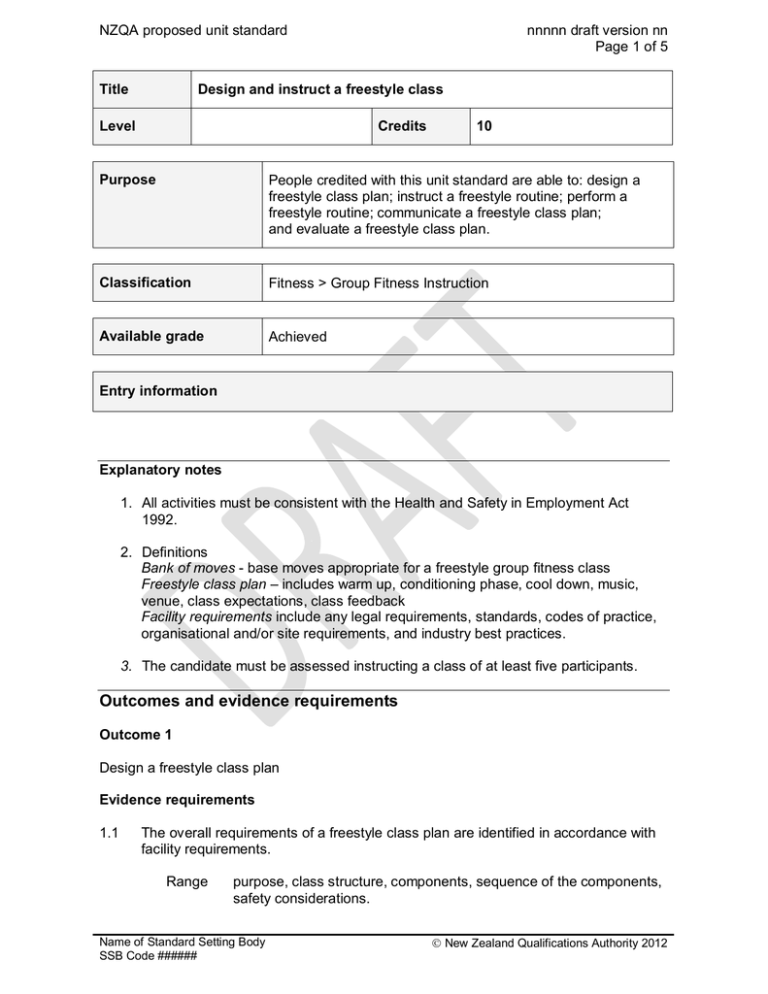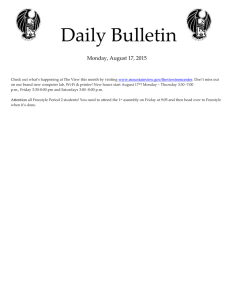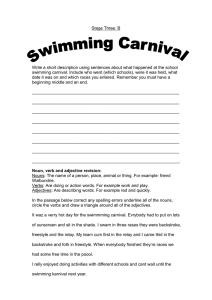Outcomes and evidence requirements
advertisement

NZQA proposed unit standard Title nnnnn draft version nn Page 1 of 5 Design and instruct a freestyle class Level Credits 10 Purpose People credited with this unit standard are able to: design a freestyle class plan; instruct a freestyle routine; perform a freestyle routine; communicate a freestyle class plan; and evaluate a freestyle class plan. Classification Fitness > Group Fitness Instruction Available grade Achieved Entry information Explanatory notes 1. All activities must be consistent with the Health and Safety in Employment Act 1992. 2. Definitions Bank of moves - base moves appropriate for a freestyle group fitness class Freestyle class plan – includes warm up, conditioning phase, cool down, music, venue, class expectations, class feedback Facility requirements include any legal requirements, standards, codes of practice, organisational and/or site requirements, and industry best practices. 3. The candidate must be assessed instructing a class of at least five participants. Outcomes and evidence requirements Outcome 1 Design a freestyle class plan Evidence requirements 1.1 The overall requirements of a freestyle class plan are identified in accordance with facility requirements. Range purpose, class structure, components, sequence of the components, safety considerations. Name of Standard Setting Body SSB Code ###### Ó New Zealand Qualifications Authority 2012 NZQA proposed unit standard 1.2 A bank of moves that might be used to design a freestyle class plan is identified in terms of exercise techniques, progressions, preparatory movements and stretches. Range 1.3 muscle groups used, the key joints involved, and the placement, path and alignment of body parts, safety considerations, tempo a minimum of 20 moves. The different components and selection of moves for each component are selected from a bank of moves to match requirements of freestyle class plan. Range 1.4 nnnnn draft version nn Page 2 of 5 warm up, conditioning components, warm down, chorography, music selection, use of learning curves, safety of moves. Prepare modifications to ensure plan is flexible to suit a range of different contexts. Range participant ability, exercise levels, correct technique, safety, temperature, environment. Outcome 2 Instruct a freestyle routine Evidence requirements 2.1 Management of class and resources ensures optimum instruction environment in accordance with a freestyle class plan. Range , , time management equipment prepared, audio levels lighting and air. 2.2 Routine is instructed in an effective and assertive manner in accordance with pre freestyle programme. Range 2.3 Effective visual instruction is applied to enable participants to complete the class in accordance with a freestyle class plan. Range 2.4 facial, gestural, postural instruction and cues, mirror imaging, right footing. Vocal quality and contrast is applied to enable participants to complete the class in accordance with a freestyle class plan. Range 2.5 word selection, safety instruction, technique correction, coaching. pronunciation and articulation, projection, tone, volume, speed. Timing of cueing is used to ensure an effective flow of class in accordance with a freestyle class plan. Name of Standard Setting Body SSB Code ###### Ó New Zealand Qualifications Authority 2012 NZQA proposed unit standard Range 2.6 nnnnn draft version nn Page 3 of 5 verbal and non-verbal pre-cues, initial cues, motivational, correctional cues, follow up cues. Anticipate, and adapt routine on the spot to suit participant requirements in accordance with a freestyle class plan. Range safety, temperature, capability of class. Outcome 3 Perform a freestyle routine Evidence requirements 3.1 Ability to distinguish between and express different musical and movement feelings is demonstrated in accordance with a freestyle class plan. Range 3.2 use of introductions, transitions, finales, peaks, ‘wow’ moments, humour, poise and flair, timing, strength and energy, enjoyment, rhythm, passion, grace Personal presentation embodies success in accordance with a freestyle class plan. Range well groomed, appropriate standard of attire, fit for the programme taught. use of introductions, transitions, finales, peaks, ‘wow’ moments, humour, poise and flair, timing 3.3 Ability to motivate participants to achieve results and keep coming back is demonstrated in accordance with a freestyle class plan. Range dramatic presentation, authentic, composure, timing. Outcome 4 Communicate a freestyle class plan Evidence requirements 4.1 Pre-class and post-class interaction demonstrates ability to motivate participants in accordance with a freestyle class plan. Name of Standard Setting Body SSB Code ###### Ó New Zealand Qualifications Authority 2012 NZQA proposed unit standard Range 4.2 greeting members, socialising, creating an atmosphere, congratulations and farewell, mingling, extra information about the programme. Class and individual focus is maintained throughout routine in accordance with a freestyle class plan. Range 4.3 nnnnn draft version nn Page 4 of 5 communication in-between tracks, eye contact made with class, word selection that is inclusive of the group, feedback on volume, eye contact, smiles may include - personalised talk directed to individuals Adaption’s to class plans are communicated in a manner that maintains class and individual focus in accordance with a freestyle class plan. Outcome 5 Evaluate a freestyle class plan. Evidence requirements Plan is evaluated in terms of design, performance, instruction, communication and feedback. Range purpose, class structure, class components, sequence of the components, safety considerations, feedback Replacement information This unit standard replaced unit standard nnnnn. [Only appears if populated.] Planned review date dd MMMM yyyy Status information and last date for assessment for superseded versions Process Version Date Last Date for Assessment Registration 1 Consent and Moderation Requirements (CMR) reference nnnn This CMR can be accessed at http://www.nzqa.govt.nz/framework/search/index.do. Please note Providers must be granted consent to assess against standards (accredited) by NZQA, before they can report credits from assessment against unit standards or deliver courses of study leading to that assessment. Name of Standard Setting Body SSB Code ###### Ó New Zealand Qualifications Authority 2012 NZQA proposed unit standard nnnnn draft version nn Page 5 of 5 Industry Training Organisations must be granted consent to assess against standards by NZQA before they can register credits from assessment against unit standards. Providers and Industry Training Organisations, which have been granted consent and which are assessing against unit standards must engage with the moderation system that applies to those standards. Requirements for consent to assess and an outline of the moderation system that applies to this standard are outlined in the Consent and Moderation Requirements (CMRs). The CMR also includes useful information about special requirements for organisations wishing to develop education and training programmes, such as minimum qualifications for tutors and assessors, and special resource requirements. Comments on this unit standard Please contact the SSB ssb@email.address if you wish to suggest changes to the content of this unit standard. Name of Standard Setting Body SSB Code ###### Ó New Zealand Qualifications Authority 2012

